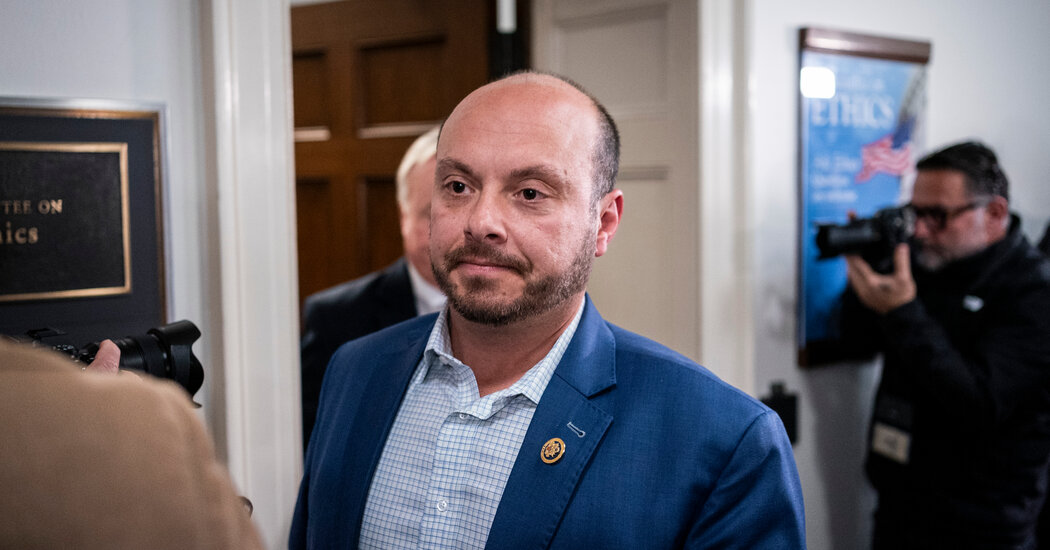Yesterday I published an article about the growing group of Republicans and business leaders who are rallying to support the clean energy tax credits that President Biden signed into law in 2022 as part of the Inflation Reduction Act.
At the center of that push is Andrew Garbarino, a House Republican from New York. He finds himself in the awkward position of fighting to protect a program that President Trump and others in Congress have vowed to eliminate in their efforts to roll back climate regulations and cut government spending.
Garbarino and 20 other Republican representatives last week sent a letter defending the tax credits to Representative Jason Smith of Missouri, the chairman of the Ways and Means Committee.
I had spoken with Garbarino for the story and wanted to share more of our conversation, including why he believes the tax credits won’t get fully repealed. He and other Republicans are trying to fend off factions from their own party, including the House Freedom Caucus, while trying to reframe the credits as pro-Trump policy.
Making the case to the GOP
Garbarino starts his pitch to fellow conservatives by trying to separate the tax credits from the Inflation Reduction Act, which was deeply unpopular with Republicans.
“I voted against the I.R.A., and there were policies in there that I didn’t agree with, just like every other Republican,” he said.
Then there’s a history lesson for his fellow Republicans. Garbarino points out that several parts of the Biden-era clean energy tax credits existed before the former president signed the Inflation Reduction Act into law. (The Renewable Electricity Production Tax Credit for electricity generated by certain forms of renewable energy dates back to 1992.)
“People don’t realize these things were not created in the I.R.A.,” he said. “They were just expanded and lengthened under the I.R.A., and a lot of them were in bipartisan bills.”
Garbarino said he had organized the letter from last week after Smith, the chairman of the Ways and Means Committee, told clean energy companies that he was hearing from members of the Freedom Caucus who want to repeal the tax credits immediately, but not from many Republicans in Congress who supported the tax credits.
Garbarino had organized a similar letter signed by 18 representatives in August. The most recent letter was signed by 21 members, including seven who did not sign the previous letter and stalwart conservatives like Representative Buddy Carter from Georgia.
“This is a line in the sand to counter what the Freedom Caucus guys have been saying, which is full repeal,” he said.
Garbarino said that more members wanted to sign the letter, including some on the Ways and Means Committee, but that they refrained from adding their signatures for strategic reasons.
He fell into the role as Congressional Republicans’ leading defender of the tax credits. Garbarino is co-chair of the Climate Solutions Caucus and has gotten to know many clean energy companies through his post. When it became clear that a package of incentives that were benefiting their industry was in jeopardy, Garbarino agreed to stick his neck out.
“Nobody else was doing it so I said, ‘I’ll do it. I’ll lead the letter,’” he said.
Pro-Trump clean energy
The president has called wind farms, one of the fastest growing sources of energy in the country, “garbage,” and has vowed to halt the construction of new ones. He has also made disparaging remarks about solar power.
But Garbarino said these technologies are essential to fulfill Trump’s campaign promises to boost domestic manufacturing and help power artificial intelligence. The clean energy industry is also rallying to protect the tax credits, as Brad Plumer reported yesterday.
“The president wants us to be an energy dominant country, and solar and wind has to be part of that discussion,” he said. “It takes 10 years to build a natural gas plant. We don’t have the technology right now for nuclear or geothermal to work on a large scale. We need energy now, and solar and wind are the quickest things to get online.”
Will Garbarino’s persuasion campaign work? He thinks so, at least in part.
“I don’t think we’re going to end up seeing a full repeal,” he said. “Could there be changes? Absolutely. That’s up for negotiation.But I think this letter shows that there is enough support that full repeal would be too painful.”
Trump administration aims to eliminate E.P.A.’s scientific research arm
The Environmental Protection Agency plans to eliminate its scientific research arm, firing as many as 1,155 chemists, biologists, toxicologists and other scientists, according to documents reviewed by Democrats on the House Committee on Science, Space and Technology.
The strategy is part of large-scale layoffs, known as a “reduction in force,” being planned by the Trump administration. Lee Zeldin, the administrator of the E.P.A., has said he wants to eliminate 65 percent of the agency’s budget.
That would be a drastic reduction — one that experts said could hamper clean water and wastewater improvements, air quality monitoring, the cleanup of toxic industrial sites and other parts of the agency’s mission. — Lisa Friedman
Read the full article.
Want cheap power, fast? Solar and wind firms have a suggestion.
As President Trump works to blunt the growth of wind and solar power and expand fossil fuel production in the United States, the renewable energy industry is making a new pitch: You need us.
Wind and solar developers are increasingly pointing out that America’s demand for electricity is soaring, and it’s proving difficult to build enough new gas plants to supply all the extra power that the nation needs.
Wind, solar and battery storage are relatively quick and cheap to construct. That could help avert energy shortages and keep prices low, an argument that renewable energy firms are making to policymakers. — Brad Plumer
Read the full article.
More climate news:
-
In response to the United States’ tariffs, Toronto is no longer providing financial incentives for Tesla vehicles, Reuters reports.
-
Grass-feed beef is not necessarily better for the planet, according to a new study featured in The Washington Post.
-
The Guardian reports that Chinese automaker BYD’s new charging system can recharge an electric vehicle in five minutes.
-
E&E News examines how a veteran oil and gas executive was picked to run the Energy Department’s renewable energy office.
Correction: The Climate Fix column in the Friday newsletter stated incorrectly the status of plans in Canada for underground disposal of spent nuclear fuel. A disposal site has been selected in Canada; the project there is no longer in the proposal phase.


